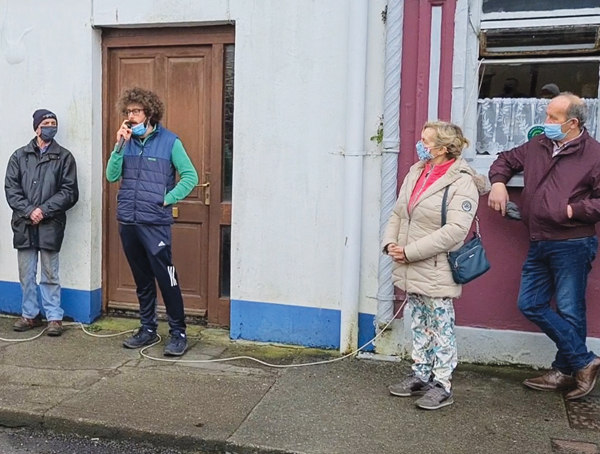Last Tuesday 23rd February marked the Centenary of that dreadful event of 1921. In those olden times, the people suffered great persecution from foreigners and the Irish race was no exception. They suffered greatly from the tyrannical soldiers called the Black and Tans who took possession of almost every village in the Country and Ballylongford did not escape. It was very fitting that this unkind deed was remembered in a dignified manner on Tuesday last as a group of people gathered and said the Rosary at the Village Cross Roads as a mark of respect and those present reminisced of the pain and the torture that local people of that time suffered at the hands of the Black and Tans.
Here through the records of local historian Padraig O’Conocubhair we trace back the events of that time. “As raids on Republican homes became more frequent and IRA men went on the run ‘Flying Columns’ were established, full time soldiers travelling all over North Kerry to attack the British Forces. On 22nd of February 1921, a party commanded Dennis Quill of Listowel accompanied by Con Dee of Ballyline, who was a column officer of the 6th Battalion who took up position around the constabulary barracks on the Well Road and George Howlett, a Black and Tan, (who were ex-army men recruited into the RIC and so called from their uniforms, a mixture of police bottle-green and army khaki) was killed, and Seaman Wills, a radio operator, was seriously wounded, as they returned to the barracks. Retribution was not long delayed. On the following evening, several lorry loads of Black and Tans and RIC from Listowel arrived in the village. “The Kerry People” reported on 5th March 1921. ‘In the history of reprisals, no place has proportionally been visited with such destruction as the prosperous village of Ballylongford.
What was at one time the business centre of North Kerry because of its port of Saleen Harbour is now little more than a smoking ruin. Seventeen buildings including a creamery, business establishments and dwellings, are reduced to ashes. The houses remaining are shattered and the occupiers confined indoors. Those whose houses were destroyed with no notice and who fled in terror at the dead of night through the discharges of rifle, revolver and machine gun fire, the rattle of petrol tins and the crackling of flames found refuge with their country friends and are afraid to return.’
Strange as it may seem, RIC Sergeants Nevin and McNamara from the local barracks, accompanied by Constable Herger, a Black and Tan, helped the locals to fight the fire. Conor Martin, who was the local doctor, confirms this and writes that they saved at least six more houses from being burnt and that he had to treat two of the police for burns received when trying to put out the flames. The usual official efforts were made to cover up what had occurred: ‘When the police were entering the village, intense rifle shotgun and revolver fire was concentrated on them from the houses. The rebels occupied the village in strength and some of them wore police and soldiers’ uniform, the people of the village were roughly handled by the rebels and their property was not spared.’ However, this effort at justifying what happened was unsuccessful because of Michael Moore, Quay Street, who was an American citizen, and who gave an eye-witness account in a letter which was published in the Manchester Guardian newspaper; ‘The shop of Jeremiah McCabe, a baker, (Bridge Street) was set on fire and the children had to be roused from the bed and flung out a back window. Several people had to rush from their houses in scanty attire.
Several houses not burnt were looted and wrecked. The house of John Kelly was one, the house of John Moran was set on fire and his wife has since died, the result of shock. Several efforts were made to set fire to the shop and public house of Mrs. Kennelly (Quay Street), but this brave woman defied their efforts, quenching the fire each time with brine from the salting tubs.’ The Ballylongford girls school attendance book reported; 23rd February 1921, attendance 0 out of 83. 24th February 1921, attendance 5 out of 83 25th February 1921, attendance 6 out of 83 – policeman shot – town burned – children afraid to come to school. On the 19th of March, the “Kerry People” reported: ‘The Dublin White Cross Society have forwarded a sum of £50 towards the relief of the poor recently affected by partial destruction of Ballylongford by fire as the outcome of reprisals. The more fortunate inhabitants, though seriously affected themselves, have with their pastor, Fr. Allman, subscribed more than £100 and a subscription of £1 has been levied on each of the farmers of the district, which it is pleasing to know has been paid willingly.’
Pictured below are some locals marking the Centenary on Tuesday. Photo: Helen Lane





